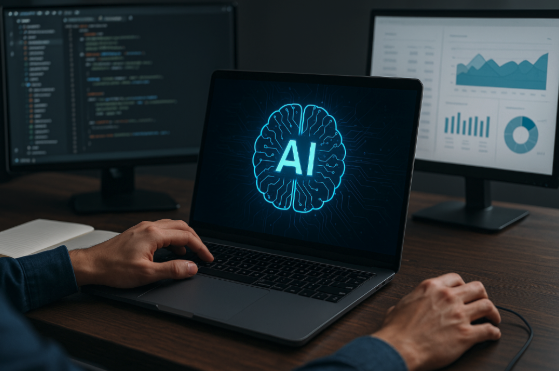
Artificial intelligence now shapes search rankings, health diagnostics, pricing engines, and even grocery delivery times. Yet the code that lets these models advise, forecast, and automate would fail without clear pathways between data, logic, and the screen that users touch. A full stack development company often sits at that crossroads, wiring algorithms to databases and endpoints to friendly interfaces.
Developers working across the entire stack understand how every stage — from the data layer up to the hover state of a button — affects model quality and user trust. By holding that wide view they spot bottlenecks early, select libraries that cooperate, and reduce costly rewrites. The end result is an AI feature that loads quickly, explains itself, and keeps data private, even as traffic climbs. For recommendations on leading firms offering these capabilities, this blog is a great place to start. To see the top Full Stack development partners, check out the curated list of companies building cutting-edge AI solutions.
Understanding Full Stack Development in the Context of AI
Full-stack practice covers every layer involved in an online service: presentation, application logic, storage, and the transport that links them. When an artificial intelligence model joins the stack, several new duties appear. A full stack development agency directs this flow.
- Data preparation – clean input is the best insurance for machine-learning quality. Full-stack coders shape collection tools, schedule batch jobs, and build validation rules so that each row meets the model’s schema.
- Model lifecycle hooks – training, versioning, and tracking belong in the release pipeline along with usual code. Developers wire CI/CD stages to call notebooks or containerized training tasks, ensuring that every deploy carries the latest weights.
- Service contracts – the output of an algorithm becomes an API. It must declare types, rate limits, and fallbacks. By controlling client and server code, full-stack teams remove hidden assumptions that often break AI features.
- Security guards – a model can leak private data if logs or debug endpoints expose raw records. Developers apply role-based rules and token checks across all routes, blocking leaks before they start.
- Observability – monitoring does not end with “200 OK.” Dashboards track confidence, drift, and resource use so a decline shows up early, not after a customer complaint.
Full-stack practice also supports experimentation. Because the same engineer commands both the training pipeline and the user interface, test variants appear quickly. A scientist can request an extra feature, the engineer adds a column, retrains overnight, and exposes the new score through a hidden panel restricted to staff accounts. Fast loops of this kind raise model accuracy while giving product owners real evidence for feature selection. Just as important, the developer documents each step, creating a clear audit chain for later compliance checks.
Why Full Stack Development Is Crucial for AI Infrastructure
Artificial-intelligence workloads stress servers in novel ways. Training pulls gigabytes per second from storage, while inference seeks millisecond replies for every click. Full stack development companies create foundations that survive both extremes.
Scalable data stores
Relational tables alone rarely meet modern volume. Developers evaluate columnar warehouses, key–value caches, or graph engines based on feature needs. Partition keys and replication groups keep reads fast even when datasets pass the terabyte mark.
Compute orchestration
Container clusters or serverless workers spin up GPU or CPU nodes when a queue of training jobs grows. Engineers script auto-scaling rules, health probes, and rollbacks so capacity rises without manual action yet costs stay under control.
API gateways
Each model version sits behind a versioned route. The gateway enforces quotas, records latency, and routes shadow traffic to canary builds. Because the same team owns client and gateway, changes appear coordinated and silent to the end user.
DevSecOps pipeline
Continuous scanning checks for license conflicts or vulnerable libraries. Secrets stay in vaults, never in plain YAML. Audit logs feed a central store that alerts on unusual access within seconds.
Cloud neutrality
Vendors update accelerators quickly. Abstraction layers — Terraform modules, Helm charts, Pulumi stacks — let a project shift between regions or even providers when price or latency calls for change.
Another vital point involves fault tolerance. AI services may depend on upstream data feeds that change without notice. Full-stack teams prepare graceful degradation paths: they cache recent predictions, flag stale data, and queue retraining tasks once a feed recovers. By blending domain knowledge with software discipline, they keep service-level targets intact even during partial outages.
They also forecast hardware budgets, using telemetry to predict when GPU fleets need an upgrade. Finally, they document the full configuration as code. Repeatable definitions let new hires spin up identical testing stacks on day one, lowering the chance of environment drift that could skew model outcomes.
The Role of Full Stack Developers in Connecting AI and User Experience
No matter how accurate an algorithm, value appears only when results reach decision-makers in clear form. A full stack development firm gives shape to that dialogue.
- Interface clarity – charts, heat maps, and ranked lists turn raw output into insight. Developers choose D3, ECharts, or native canvas to show patterns at a glance. Accessibility guides inform color choices and keyboard flows so every user can act.
- Real-time feedback – webSockets or HTTP/2 push updates without page reloads. Surge-pricing panels, fraud alerts, and chatbots feel alive because inference happens in sub-second loops.
- Error handling – when confidence drops below a threshold, the UI shows audit tools or fallback advice rather than a vague error. Such design keeps trust high.
- Personalization loops – preference data flows back to the model, closing the gap between observation and adaptation. Developers place throttles and debouncing logic on these events to avoid floods.
- Performance budget – heavy visualizations run off the main thread. Code splitting, asset compression, and HTTP caching hold first paint under two seconds even on mobile networks.
Trust grows further when users can question the machine. Good interfaces offer drill-downs, expose feature-importance graphs, and allow feedback on errors. Full-stack specialists add these controls without cluttering the screen. They integrate open-source explanation tools, wrap them in thoughtful tooltips, and log feedback straight into monitoring dashboards. Responsive-design principles keep layouts readable on phones, tablets, and widescreens, while performance audits run in CI so every commit stays within the frame budget.
User-centric testing rounds out the process.
Engineers run moderated sessions, watch where participants pause, and adjust component hierarchy or text labels until predictions feel obvious. Logging tools capture click paths so the next release cycle starts with clear action items. Over time, this evidence-based tuning lifts conversion rates and decreases support calls.
Conclusion
Artificial intelligence thrives on clear data flows, reliable compute, and human-friendly output. Full stack developers unite these needs with one skill set. They write the SQL that cleans tables, the Terraform that provisions GPUs, and the React code that explains a prediction to a clerk. This dual focus cuts hand-offs, trims deployment risk, and keeps iteration speed high.
Future products will mix predictive engines with natural language, vision, and even haptic feedback.
Engineering teams that hold end-to-end talent will meet these demands sooner and with fewer surprises. Investors like clear delivery dates, users reward speed and clarity, and compliance teams value a single point of contact for risk reviews. When AI, data, and interface design meet in one practitioner, the timeline shortens and success measures improve. That combined talent will shape the next wave of intelligent products across retail, health, and finance, setting a high bar for future competition.




